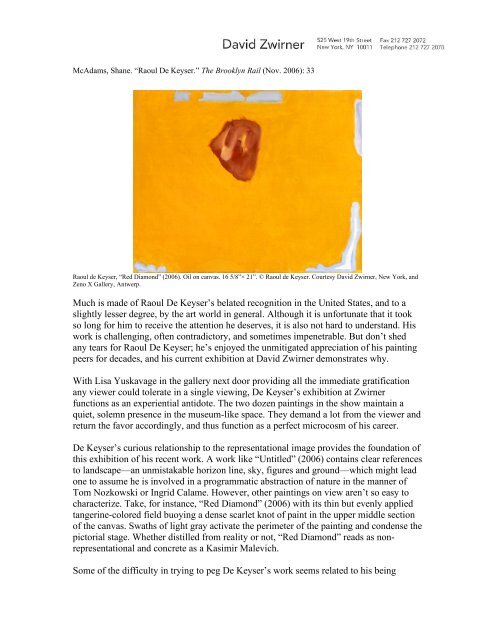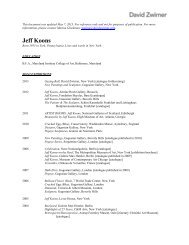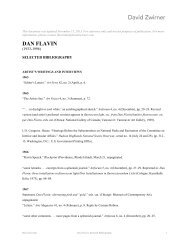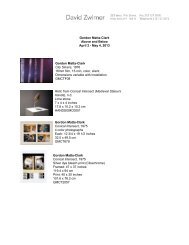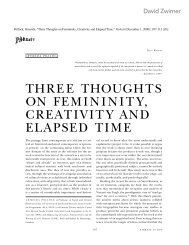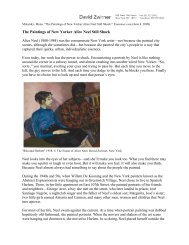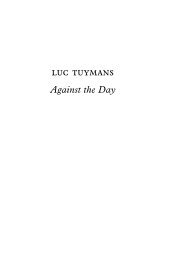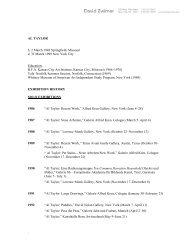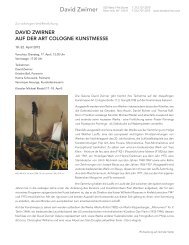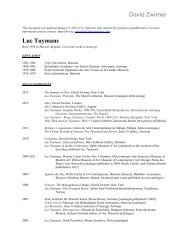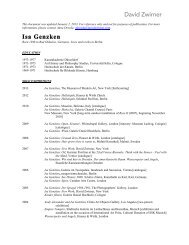Much is made of Raoul De Keyser's belated ... - David Zwirner
Much is made of Raoul De Keyser's belated ... - David Zwirner
Much is made of Raoul De Keyser's belated ... - David Zwirner
You also want an ePaper? Increase the reach of your titles
YUMPU automatically turns print PDFs into web optimized ePapers that Google loves.
McAdams, Shane. “<strong>Raoul</strong> <strong>De</strong> Keyser.” The Brooklyn Rail (Nov. 2006): 33<br />
<strong>Raoul</strong> de Keyser, “Red Diamond” (2006). Oil on canvas. 16 5/8”× 21”. © <strong>Raoul</strong> de Keyser. Courtesy <strong>David</strong> <strong>Zwirner</strong>, New York, and<br />
Zeno X Gallery, Antwerp.<br />
<strong>Much</strong> <strong>is</strong> <strong>made</strong> <strong>of</strong> <strong>Raoul</strong> <strong>De</strong> Keyser’s <strong>belated</strong> recognition in the United States, and to a<br />
slightly lesser degree, by the art world in general. Although it <strong>is</strong> unfortunate that it took<br />
so long for him to receive the attention he deserves, it <strong>is</strong> also not hard to understand. H<strong>is</strong><br />
work <strong>is</strong> challenging, <strong>of</strong>ten contradictory, and sometimes impenetrable. But don’t shed<br />
any tears for <strong>Raoul</strong> <strong>De</strong> Keyser; he’s enjoyed the unmitigated appreciation <strong>of</strong> h<strong>is</strong> painting<br />
peers for decades, and h<strong>is</strong> current exhibition at <strong>David</strong> <strong>Zwirner</strong> demonstrates why.<br />
With L<strong>is</strong>a Yuskavage in the gallery next door providing all the immediate gratification<br />
any viewer could tolerate in a single viewing, <strong>De</strong> Keyser’s exhibition at <strong>Zwirner</strong><br />
functions as an experiential antidote. The two dozen paintings in the show maintain a<br />
quiet, solemn presence in the museum-like space. They demand a lot from the viewer and<br />
return the favor accordingly, and thus function as a perfect microcosm <strong>of</strong> h<strong>is</strong> career.<br />
<strong>De</strong> Keyser’s curious relationship to the representational image provides the foundation <strong>of</strong><br />
th<strong>is</strong> exhibition <strong>of</strong> h<strong>is</strong> recent work. A work like “Untitled” (2006) contains clear references<br />
to landscape—an unm<strong>is</strong>takable horizon line, sky, figures and ground—which might lead<br />
one to assume he <strong>is</strong> involved in a programmatic abstraction <strong>of</strong> nature in the manner <strong>of</strong><br />
Tom Nozkowski or Ingrid Calame. However, other paintings on view aren’t so easy to<br />
characterize. Take, for instance, “Red Diamond” (2006) with its thin but evenly applied<br />
tangerine-colored field buoying a dense scarlet knot <strong>of</strong> paint in the upper middle section<br />
<strong>of</strong> the canvas. Swaths <strong>of</strong> light gray activate the perimeter <strong>of</strong> the painting and condense the<br />
pictorial stage. Whether d<strong>is</strong>tilled from reality or not, “Red Diamond” reads as nonrepresentational<br />
and concrete as a Kasimir Malevich.<br />
Some <strong>of</strong> the difficulty in trying to peg <strong>De</strong> Keyser’s work seems related to h<strong>is</strong> being
egarded as a “contemporary” painter. In other words, a child <strong>of</strong> postmodern<strong>is</strong>m. In fact,<br />
<strong>De</strong>Keyser came to maturity in Belgium in the 1960’s and was a member <strong>of</strong> the Nieuwe<br />
V<strong>is</strong>ie (New V<strong>is</strong>ion), a group that was heavily invested in the formal modern<strong>is</strong>m that<br />
motivated Bonnard and Cezanne, who were in turn heavily influenced by late 19th<br />
century German formal<strong>is</strong>m. In spite <strong>of</strong> the group’s allegiances, however, its other<br />
members tended toward Fauv<strong>is</strong>t coloration and relied heavily on the natural world for<br />
subject matter. <strong>De</strong> Keyser spun <strong>of</strong>f in a more eclectic, experimental direction that <strong>is</strong> at<br />
least partially responsible for h<strong>is</strong> sympathetic relationship with postmodern painting.<br />
<strong>De</strong> Keyser’s eccentricities are exemplified in “Trap,” which features a cloudlike form<br />
hovering awkwardly above a skewed triangular shape resembling a baseball home plate<br />
on a sandy field. A vertical strip <strong>of</strong> hash marks running along the left edge <strong>of</strong> the canvas<br />
flattens the painting and removes it from the representational universe. The balanced<br />
struggle between the “abstract” and the “abstracted” energizes the painting, bringing to<br />
mind the late Brit<strong>is</strong>h painter William Scott, who used informal, naïve representation as a<br />
gateway to h<strong>is</strong> intuitive, eccentric abstractions <strong>of</strong> the 1950’s. But, just as soon as a<br />
painting like “Trap” triggers a momentary association with a certain time or art<strong>is</strong>t,<br />
another <strong>De</strong> Keyser painting will d<strong>is</strong>rupt it. For instance, “Steek 1” (1987/2005) features a<br />
blue cylindrical form vertically b<strong>is</strong>ecting the canvas while a more gestural white<br />
brushstroke divides the painting horizontally. A scarlet band sneaks into the far right <strong>of</strong><br />
the canvas. The marks on the painting each come from different categories: the blue feels<br />
three-dimensional; the white feels expressive; and the red works as a formal repoussoir<br />
framing the other two. Together the forms conspire to suggest a cooler and more<br />
calculated agenda than the one in “Trap”—once again <strong>De</strong> Keyser keeps us guessing.<br />
It <strong>is</strong> impossible to neatly classify <strong>Raoul</strong> <strong>De</strong> Keyser’s paintings and not end up a mess <strong>of</strong><br />
fertile contradictions. The <strong>is</strong>olated moments <strong>of</strong> banality, incons<strong>is</strong>tency, h<strong>is</strong>tory and the<br />
sublime are all part <strong>of</strong> h<strong>is</strong> organic anti-program. As a viewer, and even more so as a<br />
writer, one must surrender to the paintings’ ineffable richness, allowing associative<br />
synapses to fire at will. The difficulty one faces in analyzing the steps in <strong>De</strong> Keyser’s<br />
work <strong>is</strong> exactly why he’s a painter’s darling; h<strong>is</strong> spare and efficient abstractions stir up a<br />
wealth <strong>of</strong> d<strong>is</strong>cussion about what painting <strong>is</strong> and where it has come from as few<br />
contemporary art<strong>is</strong>ts can.


